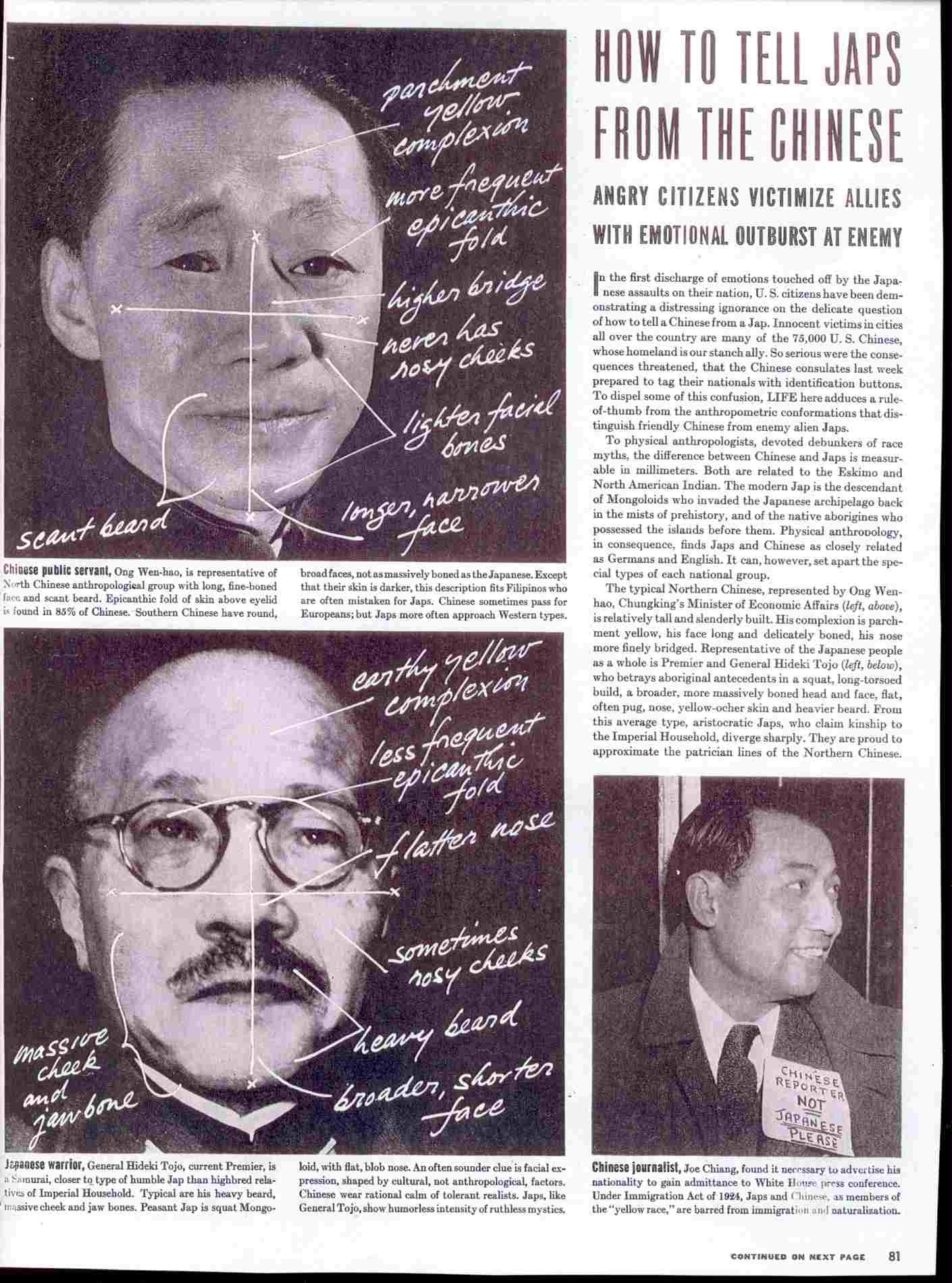LIFE Magazine, Vol. 11, No. 25, pp.81-82
December 22, 1941
Angry Citizens Victimize Allies With Emotional Outburst At Enemy
 In the first discharge of emotions touched off by the Japanese assaults on their nation, U.S. citizens have been demonstrating a distressing ignorance on the delicate question of how to tell a Chinese from a Jap. Innocent victims in cities all over the country are many of the 75,000 U.S. Chinese, whose homeland is our stanch ally. So serious were the consequences threatened, that the Chinese consulates last week prepared to tag their nationals with identification buttons. To dispel some of this confusion, LIFE here adduces a rule-of-thumb from the anthropometric conformations that distinguish friendly Chinese from enemy alien Japs.
In the first discharge of emotions touched off by the Japanese assaults on their nation, U.S. citizens have been demonstrating a distressing ignorance on the delicate question of how to tell a Chinese from a Jap. Innocent victims in cities all over the country are many of the 75,000 U.S. Chinese, whose homeland is our stanch ally. So serious were the consequences threatened, that the Chinese consulates last week prepared to tag their nationals with identification buttons. To dispel some of this confusion, LIFE here adduces a rule-of-thumb from the anthropometric conformations that distinguish friendly Chinese from enemy alien Japs.
To physical anthropologists, devoted debunkers of race myths, the difference between Chinese and Japs is measurable in millimeters. Both are related to the Eskimo and North American Indian. The modern Jap is the descendant of Mongoloids who invaded the Japanese archipelago back in the mists of prehistory, and of the native aborigines who possessed the islands before them. Physical anthropology, in consequence, finds Japs and Chinese as closely related as Germans and English. It can, however, set apart the special types of each national group.
The typical Northern Chinese, represented by Ong Wen-hao, Chungking’s Minister of Economic Affairs (left, above), is relatively tall and slenderly built. His complexion is parchment yellow, his face long and delicately boned, his nose more finely bridged. Representative of the Japanese people as a whole is Premier and General Hideki Tojo (left, below), who betrays aboriginal antecedents in a squat, long-torsoed build, a broader, more massively boned head and face, flat, often pug, nose, yellow-ocher skin and heavier beard. From this average type, aristocratic Japs, who claim kinship to the Imperial Household, diverge sharply. They are proud to approximate the patrician lines of the Northern Chinese.
Captions:
Page 81
Chinese public servant, Ong Wen-hao, is representative of Northern Chinese anthropological group with long, fine-boned face and scant beard. Epicanthic fold of skin above eyelid is found in 85% of Chinese. Southern Chinese have round, broad faces, not as massively boned as the Japanese. Except that their skin is darker, this description fits Filipinos who are often mistaken for Japs. Chinese sometimes pass for Europeans; but Japs more often approach Western types.
Japanese warrior, General Hideki Tojo, current Premier, is a Samurai, closer to type of humble Jap than highbred relatives of Imperial Household. Typical are his heavy beard, massive cheek and jaw bones. Peasant Jap is squat Mongoloid, with flat, blob nose. An often sounder clue is facial expression, shaped by cultural, not anthropological, factors. Chinese wear rational calm of tolerant realists. Japs, like General Tojo, show humorless intensity of ruthless mystics.
Chinese journalist, Joe Chiang, found it necessary to advertise his nationality to gain admittance to White House press conference. Under Immigration Act of 1924, Japs and Chinese, as members of the “yellow race,” are barred from immigration and naturalization.
Page 82
Tall Chinese brothers, full length, show lanky, lithe build of northern anthropological group that has suffered most in China’s recent history from flood, famine and war with Japs. Average height of Northern Chinese is 5 ft. 7 in., sometimes exceeds 6 ft. Most Chinese in America come from southern and coastal cities, Canton and Shanghai. They are shorter than Northern Chinese, but retain the slight proportions of the young men shown here. When middle-aged and fat, they look more like Japs.
Short Japanese admirals, full length, exhibit the squat, solid, long torso and short stocky legs of the most numerous Japanese anthropological group. Since Navy is relatively new and junior service, Jap naval officer corps numbers fewer Samurai, has more of the round-faced, flat-nosed peasant type. Over 6 ft. tall, Admiral Nomura shows traits of the big, fair-skinned hairy Ainu, aborigines who still live on reservations in Northern Japan. Special Emissary Kurusu, also atypical, looks European.
 Daily Stormer The Most Censored Publication in History
Daily Stormer The Most Censored Publication in History




